Library circulation is the function that covers all processes related to lending materials owned by the library to its users. The main processes of library circulation include checking library materials before and after lending, renewal of the borrowed items, reserve of items per user request, repairing materials, and processing payments and fines related to library materials borrowing and misuse (Wu, 2018). To ensure that library circulation is well optimized, it is critical to deploy a computerized system that tracks all circulation processes and provides an efficient architecture for their integration. Hence, this report provides requirements analysis, system and database design, and a project plan required to establish a functionally efficient library circulation system using software development methodologies.
Requirements Analysis
Problem Definition
Library circulations systems are used by reputable libraries to ensure that researchers, students, and common users have seamless access to books, sound recordings, cartographic materials, and other printed or digital forms of data for their own research purposes. Given that the volumes of user requests are large, it is essential to have a digital environment that helps to track circulation processes and related payments. Hence, the new library circulation system requires thorough technical specifications to be deployed for the newly established library based on the example of the Library of Congress Classification (LCC) system.
Issues
The following issues were identified for developing a new system that controls library circulation. First, the system should be capable of both manual and remote renewal of materials to ensure that users have access to both recent and old materials depending on their research interest. Second, the system should be enabled with tracking and reporting functionality to ensure that fines and overdue payments are recorded, as well as user history is available for library circulation desk agents for verification needs. Finally, the library circulation system should be empowered with a user-friendly interface based on UI/UX design principles to ensure high customer satisfaction and research literacy.
Objectives
The following objectives were defined as a part of the requirements analysis for the library circulation system:
- To ensure that the system operates 24/7 and provides seamless access to both users and library circulation desk agents
- To ensure that any financial activity is tracked and reported to users and library circulation agents depending on the privilege rights settings
- To ensure that library circulation agents are empowered with appropriate reporting tools, while users are comfortable interacting with a system through an intuitive interface
- To ensure that both users and agents are able to communicate and resolve potential conflicts by raising requests and asking for advice through the embedded communication module
Requirements
The following requirements were identified for the new library circulation system:
- To ensure that system architecture is capable of hosting at least a million users accessing library materials simultaneously
- To have robust security mechanisms that protect authorship rights for the library materials and impose fines for the users who violate them
- To ensure that the system has two gateways for users and library circulation system agents that are functionally linked and operate securely
- To ensure that the system is fully integrated with other electronic libraries if materials are borrowed per contractual agreement
Constraints
The following constraints were identified for the library circulation system performance:
- The system will be only available for Microsoft Windows 10, Android, and Mac users
- The system will be integrated with EBSCO search, JSTOR, and ScienceDirect databases after the launch, while further version releases will eventually expand integration capabilities
- The system does not assume the search feature associated with Google and other browsers to ensure better security and focus on customers interested in researching files of their particular specialty based on the available catalog (Wilson et al., 2015)
- There will be a restriction for uploading files for third party users of no more than 15 MB for text files, and 1 GB for video files
The new library circulation system will feature three separate user interfaces to access and modify library materials depending on the user status. The first interface will be designed for users, who will have to create and manage their own account to access library materials, process payments, raise dispute requests, and communicate with support desk agents (Singley, 2020). The second interface will be designed for library agents, who will monitor user and third-party activities, approve or reject payments and fines, and manage communication aspects (Gilpin & Bekkerman, 2020). The third interface will be designed for third parties and community partners, who will upload new materials to the library or will be responsible for content management.
Logical Model Design
Data Flow Diagrams
The data flow diagrams proposed for the new library circulation system are shown in the following figures based on user interface configuration. The first diagram shows the data flow for common users who request any kind of material from the library. It includes the returning user option for the case of denial either for login details or payment options. Additionally, it specifies the need to include e-mail address and payment source such as credit card or virtual account after registration.
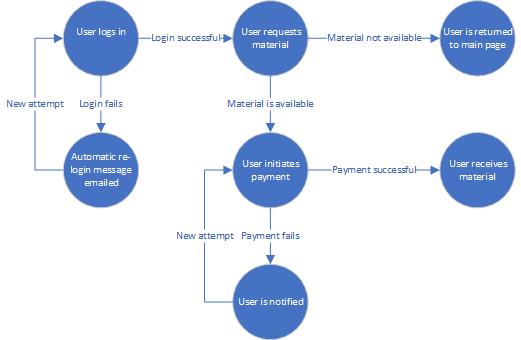
The second data flow diagram outlines the actions of the service desk agent and system messages related to customer requests. The idea behind is that agent has to check the request consistency after receiving a ticket generated by the library circulation system. First, agent should initiate verification by checking user’s profile. In case the request formulation is vague, the extra information through communication module should be requested. In case there is a record about previous fines not paid by the user or material non-availability, the agent should reject the request to access materials and send notification message based on the template. Finally, if the agent verifies user request positively, one should approve the request which would be visible to the user without additional notification messages.
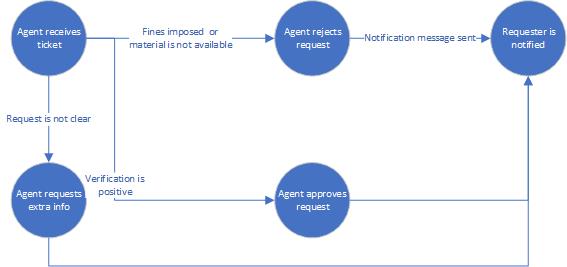
The third data flow diagram outlines the process of correcting or submitting new files to the library catalogue. The starting point for this process is the upload of corrected or new material that is either approved or rejected by the library agents. In case the material is approved, it is published and is available for users to be ordered, while publishers also receive the payment for the work and contribution. In case the material is rejected based on the library standards, it is sent back to the publisher with email notification comments about inconsistency.
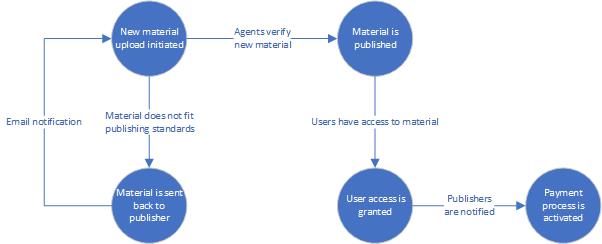
Context Diagram and Diagram
The context diagram provides a high-level overview of how users, agents, publishers, and project sponsors will contribute to the overall system functionality. As shown in Figure 4, users will benefit from receiving library materials while paying for the service, agents will benefit from salaries while providing support actions to ensure system functionality, publishers will benefit from payments for uploading or revising materials from users, and sponsors will benefit from generating revenues from operational activities. Since the scope of activities is based on customer centricity and cross-interaction, Figure 5 shows that interactions with a core system are bi-directional among users, agents, publishers, and sponsors; hence, require a thorough planning and analysis in terms of functionality. Level 1 diagram was considered as non-essential for the current project.
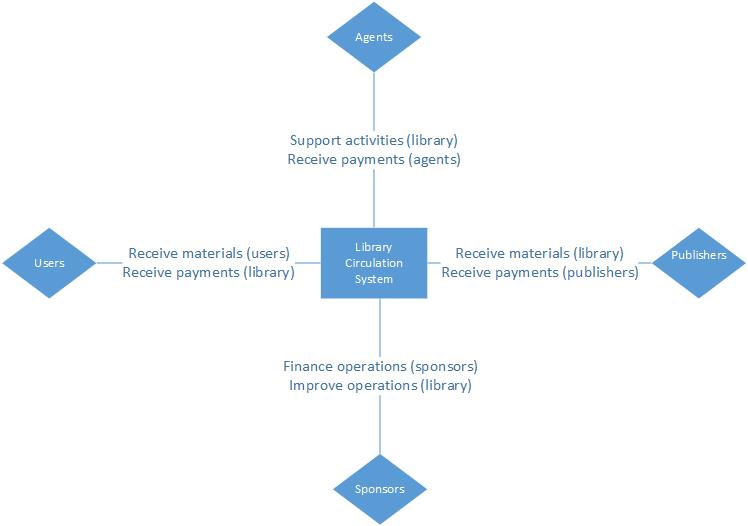
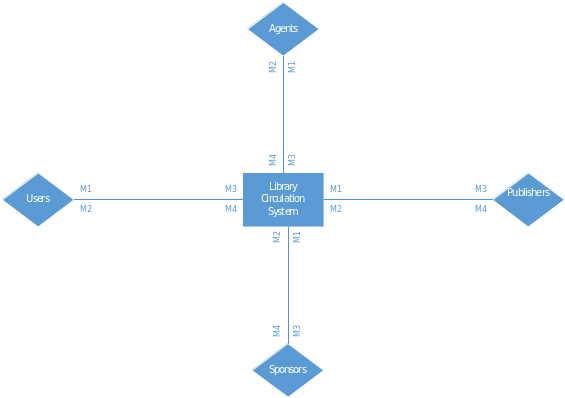
Inputs, Outputs, Performance, and Security Controls
The inputs for the proposed system will include material in text or hypertext format, a video format limited to 1080p extension to avoid heavy server loading, and pictures with an acceptable storage format of 1600 per 900 pixels resolution. The outputs will be available through either preview option when the user is logged in, or downloaded format, either using original file specifications or a converted to.pdf format. Performance settings will allow to set preferred options for browsing and downloading, as well as additional setting for changing video resolution and picture quality depending on the internet connection speed and related configurations. Finally, security controls will be based on the strong password protection policies that utilize zero tolerance architecture (ZTA), and therefore are considered being the most secure data protection solution in current digital environments.
Specific Requirements
The specific requirement for the library circulation system emerge from the contractual agreements with third party suppliers. Specifically, the requirement is to synchronize the accessibility to resources depending on the website architectures and supported data formats that are published and shared across several digital platforms. Furthermore, the consistency of shared data should be established through the verification checker plugin that is available for both users and customer support agents.
System and Database Design
User Interface
User interface will be designed following the common standards of the website usability. All users will be required to undergo a verification and authentication procedures through email address and phone number. Publishers will be additionally required to confirm user or organizational identity through a phone call and document confirmation. It is assumed that the data input in the system could be only initiated by registered publishers or customer support agents. It might be performed either using manual input or uploading files that meet the previously mentioned format specifications. The physical layout of an input assumes including user ID, choosing the type of use (i.e. customer, publisher, or agent), and further being redirected to the submodules of product retrieval, product publishing, or product management respectively (Kouzari, & Stamelos, 2018). Similarly, there would be three separate outputs for the data depending on the system privilege settings. Specifically, customers, will receive the status of their order and payment depending on the material availability, publishers will receive the status report on uploaded material, and agents will be able to track the process output via separate application module.
Data Design
Data Planning
Two cloud servers located in Europe and the United States respectively will be used to store library materials and ensure prompt access to them by users and publishers. The data will be organized per specific categories such as research subject, the date of publishing (organized in 5 years from the point of publishing), and retrieval period for the maximum of three days since the material access request was approved. The database of customers and publisher information will be stored on the local server to ensure security aspects and adherence to the data privacy principles. Therefore, the database will be interactive and is based on the heterogenic principles of data exchange. The database tables are further provided under the Figure 6. For the second and third normalization forms, we might exclude the email addresses as redundant information about the network, and focus on the status and level of access as the driving variables for decision making.
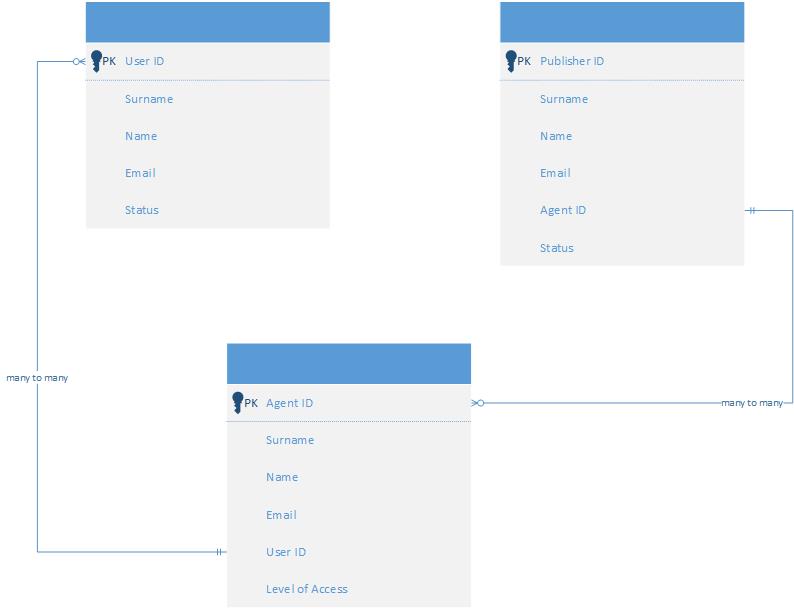
Entity-Relationship Diagram
Figure 7 provides an overview of the entity relationships for the proposed system based on the requirement analysis and user needs. It shows that entities are mostly common, while it is important to differentiate those based on user and publisher status, as well as how agents are accessing the data based on experience.
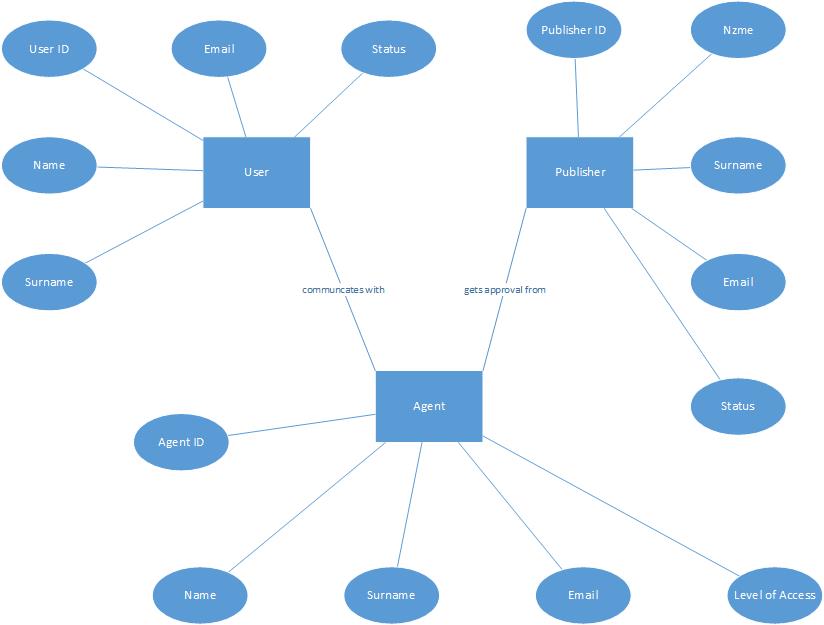
Data File Storage and Access
Both user and organizational data will be stored on the remote cloud drives, while access privileges will be different for user data and customer data. Specifically, user data requires using protection and authentication, and will be stored on the local cloud server hosted by the company. However, library data will be stored on remote servers and will require following authentication rules aligned with the third-party providers and educators. It will help to ensure data consistency and security in a global context.
System Architecture
The system will be developed on the web-based interface using JavaScript and PHP methodologies. The network configuration will be based on ZTA security architecture as a relevant method for protecting personal and copyright-protected data (Laudon & Laudon, 2020). The client-server architecture is a subject for approval with cloud server host companies, while the focus so far is made on the capabilities of licensed copy of Microsoft Azure (Laudon & Laudon, 2020). The internet interface will depend on the browser choice specified by the customer, while the intranet configuration is based on using Google Forms for reporting and common communication mediums such as Google Talk, WhatsApp, and internal application for message exchange. Overall, it will help to ensure that all individuals are able to cross-interact through the website modules and support general business objectives.
Project Plan
The preliminary project plan for the execution is attached in object file below:

References
Gilpin, G., & Bekkerman, A. (2020). Households’ public library use across the school calendar. Library & Information Science Research, 42(2), e101012.
Kouzari, E., & Stamelos, I. (2018). Process mining applied on library information systems: A case study. Library & Information Science Research, 40(3-4), 245-254.
Laudon, K.C., & Laudon, J.P. (2020). Management information systems: Managing the digital firm (16th ed). Pearson.
Singley, E. (2020). A holistic approach to user privacy on academic libraries. The Journal of Academic Librarianship, 40(3), e102151.
Wilson, D., Frazier, C., & Harter, D. (2015). Circulation policies in major academic libraries. The Journal of Academic Librarianship, 41(6), 798-803.
Wu, Y. (2018). Research and implementation of library circulation system based on block chain. CSAE ’18: Proceedings of the 2nd International Conference on Computer Science and Application Engineering, 1-4.